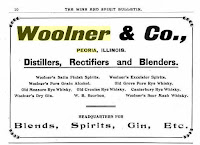Foreword: Alcohol being highly combustible it is little wonder that explosions were an all too frequent occurrence in distilleries, liquor warehouses and even “rectifiying” (blending) operations. Sometimes, as documented here, an highly destructive explosion could be triggered by a “whiskey man” unrelated to alcohol. Following are vignettes of incidents from Peoria, Illinois; New Orleans, and Virginia City, Nevada.

Their path to domination, however, was not without trauma. In the spring of 1881, the Woolners’ main distillery burned. As shown below, most of the buildings were destroyed. As shown below, only the still house stood after the blaze. The brothers immediately pledged to rebuild. Amidst the rubble the Woolners found that two tubs of fermented mash had been left virtually untouched. After slight repairs to the tubs it was decided to run the contents through a repaired still: “…The boilers were cleaned and refitted, the pumps rigged, and the distillation commenced.” The Woolners had made a terrible mistake.

Otto Karstendiek early demonstrated his abilities as a liquor and wine dealer From his Tchoupoulas Street headquarters in uptown New Orleans close to the Mississippi River, as early as 1853 he was advertising in a wide area beyond Louisiana. A Galveston newspaper ad declared Karstendiek & Company an importer of European brandies and wines as well as “Dealers in all kinds of domestic liquors….” By the end of the decade Otto was doing business from two New Orleans warehouses, each four stories high and a block long. Both were filled with liquor.
On Saturday, October 13, 1860, tragedy struck. About 8 p.m. a large fire of undetermined origin broke out in one Karstendiek warehouse. Soon the structure was engulfed in flames from the ground floor to the roof, imperiling the second warehouse. When the fire reached the top floor where considerable liquor was stored, a tremendous explosion occurred, destroying both warehouses and spreading the fire to adjoining structures.



What Van Bokkelen’s fellow citizens likely did not know was that he also was experimenting with more volatile explosives. In August 1973 the New York Times printed a letter from a man named White that stated: “When I visited Gen. Van Bokkelen, he told me that he would soon have a blasting agent in the market that would excel giant powder [dynamite].” On my asking what it was, he turned to [six] cases and opened them, showing me the gun-cotton saturated with nitro-glycerine, together with the cotton pulp mixture.”
At 10:45 p.m. on June 29, 1873, a huge explosion rocked Virginia City. When the dust and smoke cleared, ten people were found dead, among them General Van Bokkelen. His body was found in a corner of his room, “his features so bruised and charred as to be unrecognizable,” read one newspaper account. Other victims were three local merchants, a female hotel owner, three other men and an eight-year old girl. Many were killed by falling timbers and bricks. One man died when he was stuck by an iron door hurled the distance of 100 feet.
A number of Virginia City buildings were destroyed or severely damaged. They included the Bank of California, Armory Hall, Daly’s Saloon, a grocery store and a building that used the upper floor as a lodging-house. The city went into mourning and flags were flown at half mast. The city’s Fourth of July celebration was canceled and the money collected for it used to bury the dead. Subsequent days were filled with funeral processions wending through the gates of the local graveyard.

Note: Longer posts on all three men may be found on this website: The Woolners, July 8, 2021; Otto Karstendiek, August 25, 2021, and Jacob Van Bokkelen, December 19, 2020.



No comments:
Post a Comment